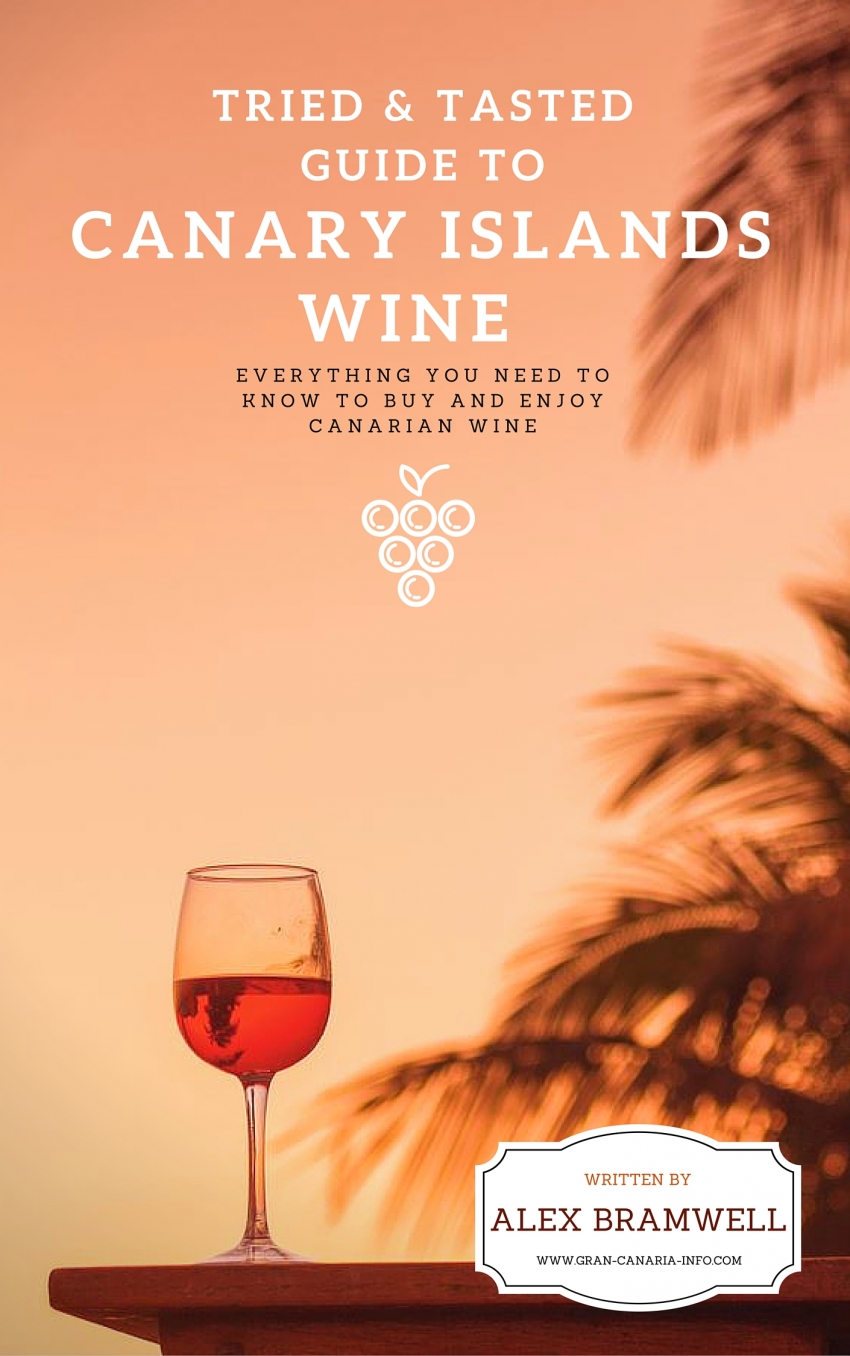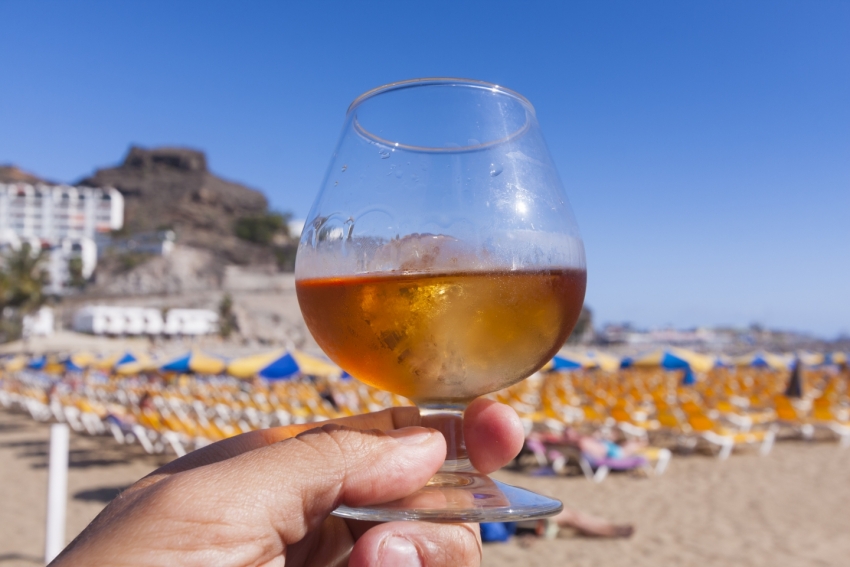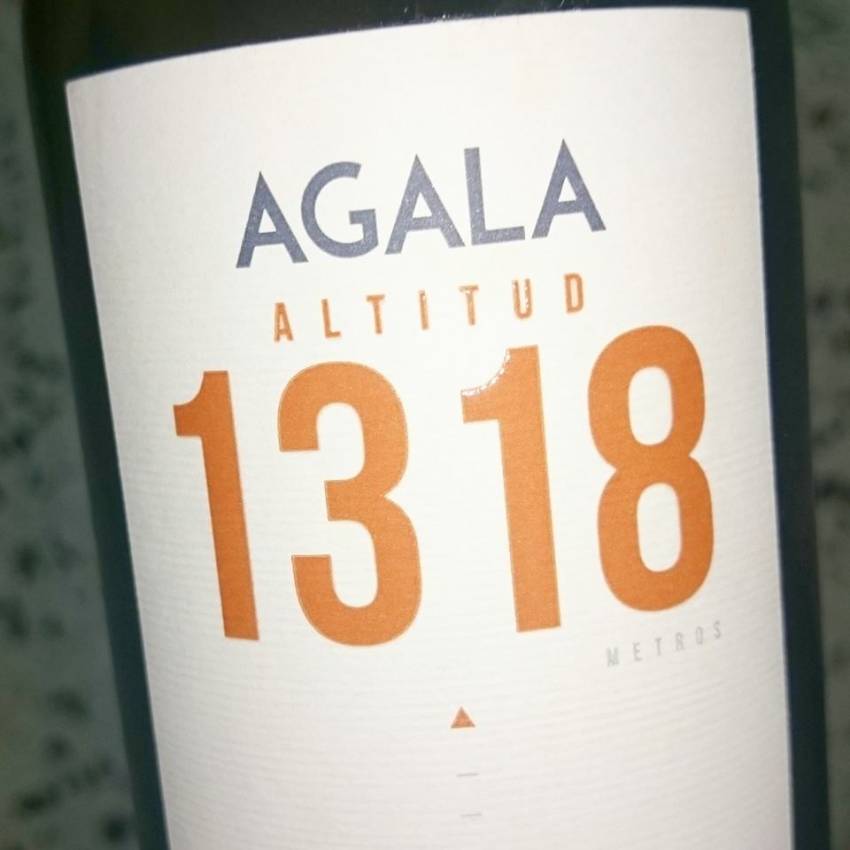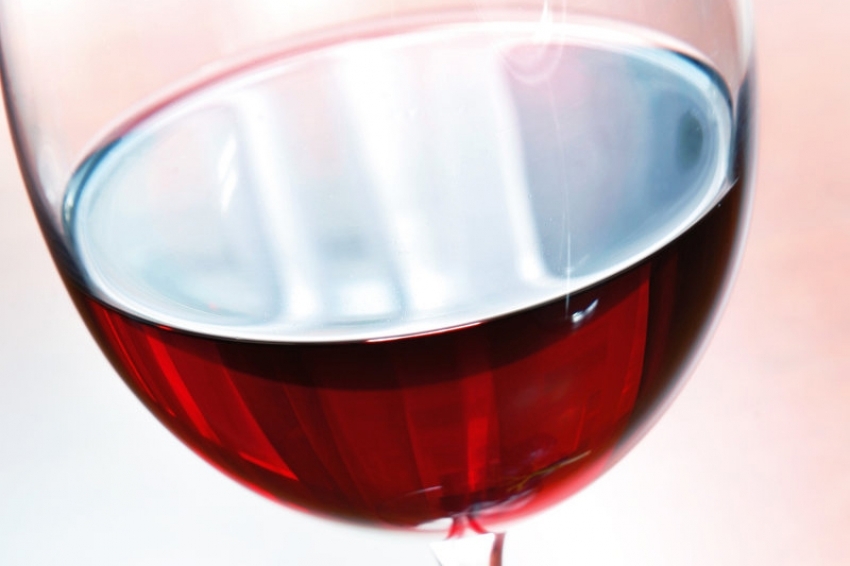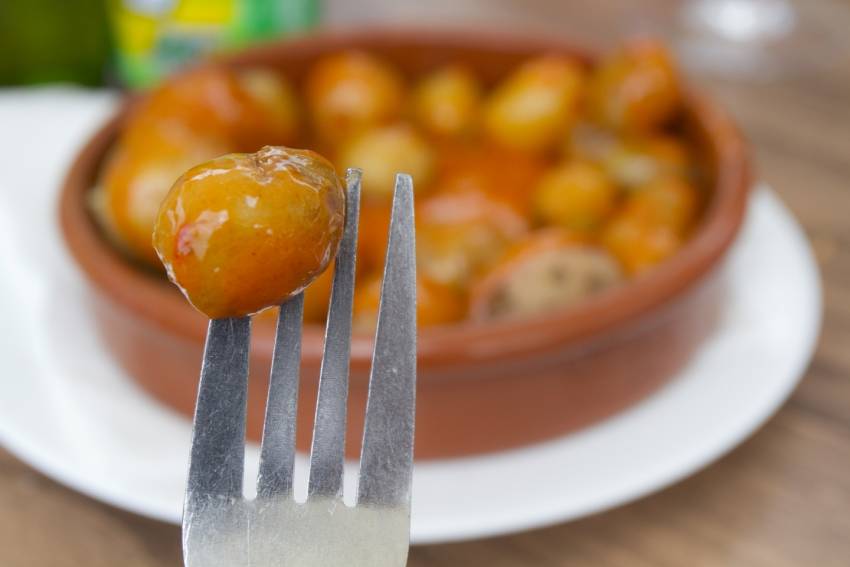Tried & Tasted: Guide To Canary Islands Wine
The wines of the Canary Islands, born of lava and sunshine and pressed from rare and ancient grapes, are a the highlights of the islands that most visitors miss out on. We want to change that, so here's the book that helps you understand and enjoy them.
It's Official: Gofio Is Good For You:
Top 10 Things You Have To Eat In Gran Canaria That Aren't Papas Con Mojo
Everybody loves a plate of papas con mojo, but there's more to Gran Canaria food than salty potatoes. From great steak to cactus fruit, here's ten things that have to try before you leave.
Viña Norte: Award Winning Carbonic Maceration Red From Tenerife
Tajinaste Blanco: A Fantastic Tenerife White Wine
The Costa Meloneras hotel in Gran Canaria have this on their a la carte restaurant wine list and it's a great example of a dry Canary Islands white.
Western Wonder: Teneguia White Wine From La Palma
This excellent La Palma dry white is superb value and rivals any Spanish white you can buy for the price in Gran Canaria's supermarkets.
Canary Islands Wines: La Palma's La Gota
This is one of the best value Canarian white wines and is easy to find in Gran Canaria's supermarkets.
Gran Canaria Drinks: The Island's Top Tipples
So you're in Gran Canaria and wondering what to drink. If it seems a shame to fly to a volcano and stick to British lager and Spanish wine, then read on and take your pick of the best local booze.
The Eight Types of Gran Canaria Restaurant
You find them in caves, hanging out over the sea and clustered together in shopping centres but most Gran Canaria restaurants belong to one of these eight kinds.
Gran Canaria Wines: Agala 1318 Altitud (was) Sex in a Bottle
The Winery
The Agala winery is called Bodegas Bentayga. It's between Tejeda and Artenara and at up to 1318 metres above sea level it's one of the highest in Spain. The vines grow on small terraces on steep terrain and experience a vast range of temperatures. This area of Gran Canaria gets snow during cold winters and can reach over 40ºC during hot summers.
As with most Canarian wineries, Bentayga grows local grape varieties and hand picks the grapes: 1318 is made with a blend of Albillo and Vijariego.
Visits are possible but only from Monday to Friday, minimum six people and 72 hours notice. They cost 8 euros per person and include the chance to buy wine at bodega prices. Book here.
Agala 1318 is available in good wine shops and at the wine stall in the Santa Brigida weekend market.
2021 reviewed of oaked Agala Altitud dry white wine
This wine has been one of the best Gran Canaria whites for several years. Grown in South Central Gran Canaria, it had that zing you get from blasting white wine grapes with the extremes of temperature and climate (snow to 40C) you get at over 1000 metres above sea level.
Back in 2015 we reviewed it as "a floral nose with apricot and a touch of sweetness. In the mouth, it is dry but rich with well-balanced acidity. You get intense fruit and flowers, and a floral finish with a little bitterness".
It was all about the blossom!
The concept has evolved since then and this wine now spends time sobre lías in French oak barrels.
Oak and dead yeast add intensity and depth of flavour at the expense of freshness. But is it worth all that extra effort? Can you take an excellent "drink now" Canary Islands wine and turn it into something deeper? Why would you want to?
Oak, melon and banana on the nose. Quite exciting at first sniff but there's a tired hint to the wood after a few more.
Good acidity in the mouth from the vijariego, richness from the albillo. A hint of butter and vanilla from the oak and lías. Melon and banana.
Blah blah blah!
Bring back the old version we say. The oak and butter don't make up for the lost blossom and freshness.
Check our latest Gran Canaria and Canary Islands wine reviews on our Canary Islands Wines Facebook Group.
Great Value Canary Islands Wines You Have To Try in Gran Canaria
The Canarian wine scene hasn't buzzed this much since Shakespeare's time. New wineries start up every year and there's always a new wine to try. However, because most wineries on the islands are small you can only buy them close to where they are grown. Great if you have the time and transport but a pain if you're in Gran Canaria on holiday.
Top Six Scary Gran Canaria Seafood Dishes
Canarian food is famous for its simple, tasty seafood like fried squid rings, delicious prawns and fish stew. However, delve a bit deeper into the local cuisine and some more exotic ocean ingredients and seafood dishes pop up.
Alex Says: 25 years ago I remember watching old women in Lanzarote, wearing huge hats and head scarves, munch their way through a whole bucket of live sea urchins or erizos de mar. The cracked each one open and sucked out the fresh roe, before baiting their fish traps with the shells. The fresh roe is soft and a bit slimy, but tastes fresh and slightly fishy. In Japan, it is highly prized for top quality sushi.
Live Sea Urchins
Sea urchins have become such a problem in parts of the Canaries that the government is trying to get Canarians to eat them more often. The roe, cooked down into a sauce, tastes intensely of the sea. Trouble is, you need to collect a lot of spiny urchins to make a plate of pasta! Each one gives you half a teaspoon of eggs.
Grilled Limpets
Another local speciality is grilled limpets or lapas, served with green mojo sauce (made from garlic, fresh coriander, chilli, vinegar and oil). Limpets are hard to collect because they live on rocks in rough areas and clamp down if you try and dislodge them. The best way to get them is to sneak up and side swipe them with a rock or an iron bar. Cooking limpets is easy as they come in their own little pot: Just add a dash of lemon juice and a teaspoon of green mojo to each upturned limpet, and put them under the grill until the meat comes away from the shells. Limpets are tasty but a little bit chewy, especially if overdone.
Harvesting mussels and limpets is currently restricted in the Canaries, and especially on Fuerteventura, as over-collection was damaging the ecosystem. The limpets you find in small local bars are almost all imported. They still taste the same, and the freezing even makes them slightly tenderer!
Fried Moray Eel
Moray eels are fatty and full of bones, with hardly any meat at all. That doesn't stop Canarians from chopping them up and deep frying the bits until they go crispy. Then they chew up the crisped eel (morena frita) and spit out the bones. Moray eel is very satisfying because it is greasy and tasty, but most people are put off by the bones. Personally, I prefer my moray eels live and wriggling about! They get up to six feet long and make the islands a more attractive Scuba destination.
Octopus Old Clothes
Octopus old clothes (ropa vieja de pulpo) is a stew made from chickpeas, onions, tomatoes and octopus. It is called old clothes stew or "ropa vieja" because legend states that it was first made by a man so poor that he boiled his own clothes. When he took the top of his pot, he found this delicious dish inside instead. When you sit down to a dish of octopus ropa vieja, try not to picture the naked man who first ate it!
Poached Parrotfish
Poached parrotfish (vieja jareada) is an iconic Canarian dish that never gets onto tourist menus because the Canarians keep all the parrotfish to themselves. They are beautiful, multi-coloured animals, with big beaky teeth, that live in shoals and eat crabs and urchins. Their meat is soft and flaky and falls apart unless cooked with care. Viejas are poached whole with onion, peppers and laurel leaves and served with the skin unbroken.
Viejas are traditionally caught from small boats using a glass-bottomed box or "mirafondos", and a cane rod tipped with a dried stingray tail for sensitivity. The fisherman, in a small rowing boat, moves over the rocks until he spots a shoal of viejas through his mirafondos. Then he drops his line, tipped with a long iron hook baited with a small crab amongst the fish. The big hook is essential as viejas can bite through nylon and small hooks with their strong teeth. Once a vieja bites, the fisherman whips it up away from the school quickly so as not to spook the others.
Viejas became very rare because of overfishing but are now staging a big comeback thanks to marine reserves and fishing limits.
Stewed Cuttlefish
Cuttlefish are related to squid but have slightly sweeter meat. In the Canaries, they are stewed until very tender in white wine along with bay leaves and garlic. The dish is called chocos en salsa: It's rich and exceptionally tasty!
Come across any other weird seafood in the Canary Island? Let me know and we'll add it to the list.
Where In The World Can You Eat Old Clothes and Wrinkly Popes?
That would be the Canary Islands, where some traditional food dates back to prehistoric times but all of it is bursting with island flavour.
Going Green: Canary Islands Green Mojo Sauce Recipe
Mojo is the quintessential Canaria sauce. The red form, served with little wrinkled potatoes is the most famous kind, but the herby green variety is just as good. It's intense colour and flavour come from fresh coriander (cilantro).
Green mojo is traditionally served drizzled over big pieces of boiled potatoes, on fried fish or on slices of octopus. On Gran Canaria you rarely get it with wrinkly potatoes (papas arrugadas) but it is served this way on other islands.
Mojo verde is very similar to Portuguese salsa verde but uses coriander instead of parsley. It may be yet another reminder that many of the earliest settlers in the Canary Islands came from the Portuguese island of Madeira, just to the north of the Canaries.
To make enough mojo for a decent dipping session you need:
A good bunch of fresh coriander
Six fat cloves of garlic
Half a teaspoon on cumin seeds
A big pinch of salt
One fresh green chilli pepper
Olive oil
Cider or wine vinegar (not malt vinegar: too strong)
A hand full of breadcrumbs to thicken
Grind up the coriander leaves and the tops of the stalks with the garlic, salt, chilli and cumin. You can use a blender but a pestle and mortar does a better job. You want to end up with a smooth paste with no oil floating on top.
Add about 200 ml of olive oil and 50 ml of vinegar and mix well until you get a thick, sticky sauce. If the mixture is too thin add some breadcrumbs. If it is too thick dilute it with a bit of white wine.
Serve mojo verde straight away as a dipping sauce with crusty bread, or with almost any other Canarian dish. It goes particularly well with fried fish. You can store it in the fridge for a couple of days but it loses its flavour quickly.
Some people add a handful of green peppers (capsicum) and a teaspoon of dried oregano leaves. Other substitute half the coriander for parsley. These extras are not traditional but do create a green mojo sauce with more depth of flavour.
The Legendary Red Mojo Sauce: Gran Canaria Recipe
Mojo sauce is the Canary Islands' most famous condiment and one half of "papas arrugadas con mojo", our most popular dish. It is tasty, garlicky and spicy, but not actually that fiery unless you get Mojo Picon; the chilied up version.
Mojo sauce is either red or green (mojo rojo and mojo verde) depending on whether it is flavoured with paprika or fresh coriander. Both types also contain oil, vinegar, cumin, garlic and chili. The red form is served with small, salted potatoes while the green form is traditionally served with fish.
The name mojo probably comes from the Portuguese word molho, which means sauce: A reminder that many early Canarian settlers came from the nearby Portuguese island of Madeira. They migrated to the Canary Islands to start off its sugar cane industry.
Red Mojo Recipe
Makes enough for a good portion of mojo sauce for papas arrugadas for four people.
Ingredients
5 garlic of cloves
A teaspoon of cumin seeds
2 or 3 dried birds eye chilies, more for Mojo Picon
A good pinch of salt
A teaspoon of smoky paprika or pimentón
3 tablespoons red wine vinegar
5 tablespoons olive oil
3 or 4 tablespoons breadcrumbs to thicken
A splash of water to loosen the sauce, or a couple of roasted tomatoes.
Method
Dry fry the cumin until it starts to pop to release its flavours. Grind it up in a pestle and mortar along with the dried chilies, salt, pimentón and the garlic cloves until you get an even paste. Add the olive oil and vinegar and mix well. Add breadcrumbs to thicken and water to loosen. Mojo should be thick enough to stick to the potatoes but not be lumpy.
Mojo Rojo is almost always served with papas arrugadas: Small potatoes cooked in sea water or very salty water. The salt sucks water out of the potatoes, leaving them with wrinkled skin.
To make papas arrugadas boil small potatoes in just enough sea water or salty water to cover them. Leave the pan uncovered and cook until the water is almost all gone. Leave them in the open pan until they are dry and the skin is covered with a fine white crust of salt.
To make proper papas con mojo pour the sauce generously over the potatoes rather than in a separate dish. Squash each potato before removing it from the sauce for maximum absorption. Papas con mojo goes brilliantly with good Canarian goat's cheese.
"Horrible" Gofio: The Canary Island Soul Food
Gofio is soul food in the Canary Islands. Most Canarians were weaned on bananas mashed up with gofio and many still eat it every day. It is so tightly entwined with local identity that it is best not not to tell anyone on the islands if you don't like it. At the same time Canarians aren't stupid. They enjoy cake and chocolate and ice cream just like everyone else. They wouldn't eat gofio if it was horrible. Wwould they?
Gran Canaria Foods That The Locals Love
Canarian restaurants all serve delicious papas con mojo and goat cheese, but there are lots of Canarian foods that don't make it to the menus. Here are the top ten local favourites that you have to track down on your own.
Donuts
Gran Canaria Donuts are light and sweet with a hint of lemon and knock the socks of those stodgy Crispy Crème things. They come as traditional sugar or chocolate doughnuts with a hole, or with a chocolate or custard filling. Donuts are sold in most Gran Canaria newsagents, bars and corner shops. Avoid on Sundays as there are no weekend deliveries and Donuts go stale in hours.
Bocadillo de Calamares
Deep fried squid rings in a bread roll with plenty of lemon juice. The quintessential Canarian beach snack and available at any local bar or café close to the sand. For the best ones pick a bar with a stream of locals walking out carrying plastic bags.
Barquillo
Barquillo is ice cream cone without the cold filling. It comes in sheets or rolls and is a popular Canarian beach snack, especially on Las Canteras Beach in Las Palmas. Watch out for vendors walking along the beach carrying a basket.
Polvitos
A dessert that has taken Gran Canaria by storm that we think was invented in the Novillo Precoz (a fantastic steak restaurant) on Calle Portugal in Las Palmas. Polvitos are basically cheesecake made with whipped cream instead of cheese. They are flavoured with dulce de leche and are sweet and moreish. Some Gran Canaria restaurants have given up serving any other pudding.
Nisperos
Known in English as loquats these little orange fruits are common all over Gran Canaria but rarely make it into the shops as they rot quickly. To eat a nispero bite off the stalk and squeeze out the juicy flesh in one go. Don’t forget to spit out the big, brown seeds. Their flavour is delicate and a bit like tangerine.
Pollo en Adobo
This never makes the list of traditional Canarian foods, but it's on most dinner tables at least once a week. Pollo en adobo is chicken marinated in lots (and lots) of garlic and fresh coriander and then fried. Pungent and delicious!
Sandwich Mixto
It’s hard to believe that two bits of white bread and a slice of ham and cheese can be so delicious. The sandwich mixto is the Canarian version of the ham and cheese toastie and is served for breakfast and as a snack at any time. The secret is in grilling the bread with plenty of butter.
Leche y Leche
An espresso shot with a dash of milk and a tablespoon of condensed milk to sweeten it. The condensed milk sits at the bottom of the cup and you have to stir it well before drinking. In Tenerife order a baraquillo and in Lanzarote a café bonbon.
Clipper
Clipper is Gran Canaria’s answer to Fanta and Coca Cola. It’s a virulent red colour and tastes of strawberry air freshener. Canarians are proud of their local soft drink and guzzle it by the gallon. Try it if you have a sweet tooth but don’t ask too many questions about the colour and watch out for stains! For the cautious there are clipper flavoured ice lollies that taste pretty good.
Pepe Chiringo
Don Pepe started with a hot dog cart and now owns a chain of fast food restaurants in Gran Canaria. The food is cheap and cheerful and goes down well after a few beers. There is one on Avenida Tirajana in Playa del Inglés and another by the big park in Maspalomas. Gran Canaria’s answer to the Golden Arches and without the creepy clown!
Do you have a favourite Gran Canaria food that never makes the Top Ten lists? Let us know and we'll add it to the list
The Top Ten Canarian Foods That Everybody Should Try
Canarian food is one of the highlights of a holiday in Gran Canaria. Try it in local restaurants in the capital Las Palmas or in the hill towns. The Canary Islands dishes served in the resorts are rarely any good.
Papas Arrugadas
The Canarian dish that everybody tries and most people love. Papas arrugadas or wrinkly potatoes are small potatoes boiled their skin in sea water until the wrinkle up and develop a thin crust of salt. They are served covered with Mojo Picon, a spicy sauce made of olive oil, cumin,chili peppers, raw garlic and vinegar. The Canarian word of potato is papa, which also means pope. Some mistranslated English menus describe papas arrugadas as “wrinkly popes”!
Gofio
The staple diet of the pre-Hispanic indigenous Canarians, who did not survive the Spanish colonisation of the island, gofio is a nutritious flour made from pre-roasted barley or maize. Add it to coffee for a stomach-lining breakfast or try gofio escaldado, a sort of thick porridge flavoured with mint and eaten with raw red onions. Gofio is an acquired taste!
Sancocho Canario
A festival dish that is served on Sundays and at local Romerias (Canarian fiestas), Sancocho is a stew made from salted cod fish and sweet potato. Sancocho is traditionally served with pella de gofio, a soft paste made out of roasted maize flower and water. Sancocho is various forms can be found all over South America but the Canarian version is the original.
To be perfectly honest sancocho is incredibly fishy and salty and hardly anyone who isn't Canarian likes it.
Tropical Fruit
The subtropical climate of Gran Canaria means that it is one of the only places in Europe that can grow tropical fruit. Mangos, papayas, cactus fruit (tunos), pineapples, guavas, water melons and of course bananas are all grown locally and can be found in the main shops and markets. Canarian bananas are smaller than Caribbean ones and much tastier!
Ropa Vieja
Literally translated as “old clothes”, ropa vieja is a tasty stew made from chickpeas and chicken or beef, flavoured with bay leaves. Traditionally it was made from the meat leftover after making soups. There is a local myth that ropa vieja was invented by a man so poor that he made soup out of his clothes, which turned into this delicious dish.
Potaje
A thick and tasty vegetable soup made from potatoes, corn cobs and mixed vegetables, often with lots of watercress in it. Potaje is a good option for vegetarians. Most local restaurants make a different potaje every day.
Carne de Cabra
There is nothing better than slow-cooked, fatty goat meat served in huge portions. While lots of people think goat meat has a very strong taste, the Canarian way of stewing it on the bone makes it juicy and delicious.
Pata Asada
A staple snack, pata asada is roast pork, served cold sprinkled with sea salt. Done well it is moist and addictive! Done badly, it is shoe leather!
Squid and Octopus
There aren't many crabs and lobsters around Gran Canaria but there is plenty of squid, octopus and cuttlefish and Canarian cooks do them all justice. Squid is fried in rings (calamares fritos) and soaked in lemon juice and octopus is sliced thinly and served covered in sea salt and paprika (pulpo a la Gallega). Tiny squids are deep fried and served whole (puntitas de calamar) while cuttlefish are stewed with potatoes (choco en salsa)
Deserts
Truchas de batata are similar to turnovers and are filled with sweet potato while huevos mole is thick custard flavoured with lemon peel and cinnamon. With any desert, ask if it is home made (casero) to avoid disappointment. Mazapan is dense shortcake made from almond flour that is sold in the mountain villages.Also don't miss Guarapo, a sweet, almost black syrup made only on La Gomera from palm tree sap.

